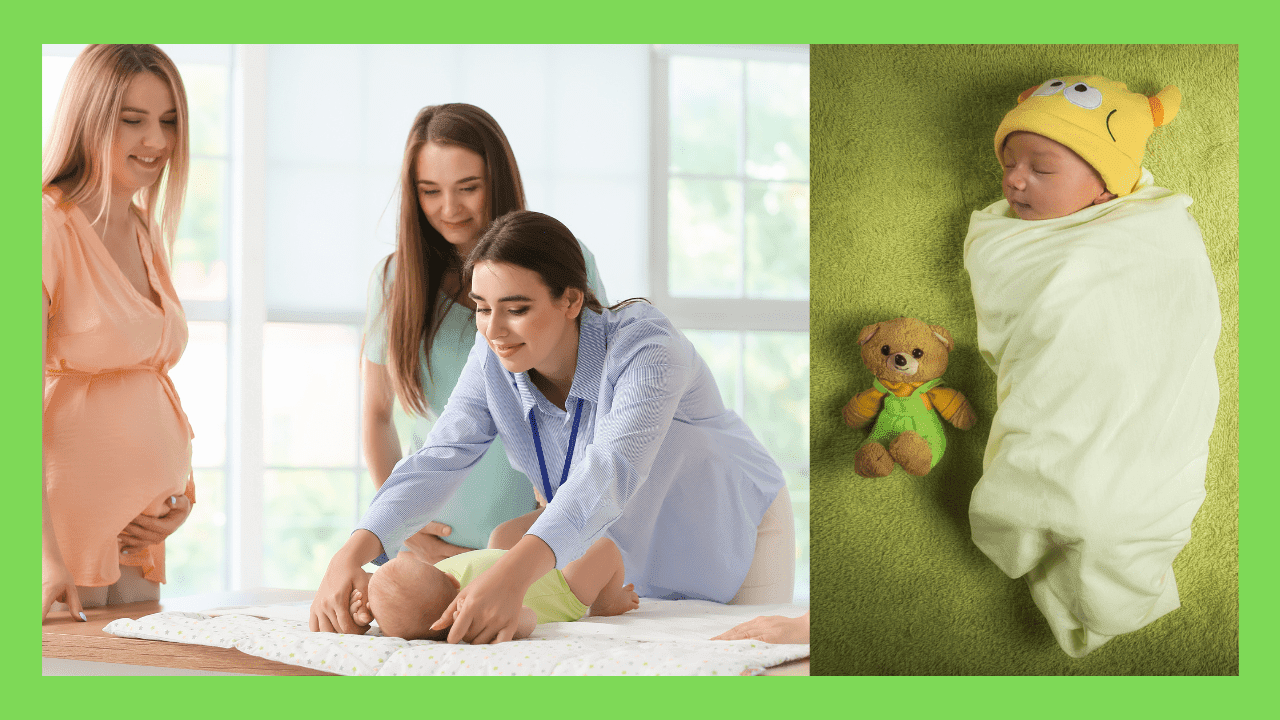Here’s an overview:
Introduction to Swaddling
Swaddling is a traditional practice used to calm and comfort newborns by wrapping them snugly in a blanket. This technique helps to replicate the cozy environment of the womb, reducing startling and promoting better sleep. For many new parents, understanding the basics of swaddling is essential to ensuring their baby’s safety and comfort.
Key Benefits of Swaddling:
- Reduced Anxiety: Helps babies feel secure and less fussy.
- Enhanced Sleep: Limits the startle reflex that can wake them.
- Easier Transition: Mimics the womb’s tightness for newborns.
Parents should follow safe swaddling guidelines to prevent issues like overheating or hip dysplasia.
Benefits of Swaddling
Swaddling offers numerous advantages for both infants and parents.
- Improved Sleep: Swaddling helps babies sleep longer and more soundly.
- Reduced Crying: Swaddled babies tend to be calmer and cry less.
- Enhanced Comfort: Mimicking the womb, swaddling provides a sense of security.
- Prevents Startle Reflex: Swaddling limits the reflex that causes babies to wake up suddenly.
- Temperature Regulation: Keeps babies warm without the need for loose blankets.
- Promotes Back-Sleeping: Encourages the safest sleep position, reducing SIDS risk.
- Ease of Handling: Makes it easier for parents to hold and carry their newborns.
When to Start and Stop Swaddling
Swaddling typically begins from birth. It helps newborns feel secure and sleep better by mimicking the snugness of the womb. Parents should pay close attention to the following guidelines:
- Start swaddling immediately after birth until around two months old.
- Stop swaddling when the baby shows signs of rolling over, which is usually between two and four months. Safety comes first.
- Transitioning out of swaddling gradually can help ease the baby into sleeping unswaddled.
- Consider using a sleep sack as an intermediate step for added comfort and security.
Monitoring for signs of distress or discomfort is crucial during this period.
Choosing the Right Swaddling Material
Selecting the appropriate material for swaddling is crucial for the baby’s comfort and safety. The following points should be considered:
- Breathability: Opt for materials like cotton or muslin, which allow air circulation to prevent overheating.
- Softness: Ensure the fabric is gentle against the baby’s sensitive skin to avoid irritation.
- Stretchability: A slight stretch in the material can help achieve a snug fit, offering a sense of security to the baby.
- Durability: Choose fabrics that can withstand frequent washing without losing their shape or softness.
- Seasonal Appropriateness: Select lighter materials for warmer climates and slightly thicker fabrics for cooler environments.
Remember, the baby’s comfort and safety are paramount when selecting swaddling materials.
Preparing the Swaddling Area
Ensure the area is clean and flat, such as a changing table or a bed. Gather all necessary supplies: a swaddling blanket, a diaper, and baby clothing if required. Wash hands thoroughly to maintain hygiene. Lay the blanket in a diamond shape with the points at the top, bottom, and sides. Fold the top point down to create a straight edge. Place the baby gently on the blanket, ensuring their head is above the folded edge. Keep the baby’s arms at their sides or bent slightly at the elbow, depending on their comfort and developmental needs.
Step-by-Step Swaddling Instructions

- Lay Out the Blanket: Place a swaddling blanket on a flat surface in a diamond shape.
- Fold the Top Corner: Fold the top corner down about 6 inches to create a straight edge.
- Place the Baby: Lay the baby face-up on the blanket with their neck on the folded edge.
- Secure the First Arm: Hold the baby’s right arm down and pull the left corner across the body, tucking it under the baby.
- Fold the Bottom: Fold the bottom corner up over the baby’s feet.
- Secure the Second Arm: Hold the baby’s left arm and pull the right corner across the body, tucking it under securely.
Safe Swaddling Techniques
Proper swaddling is essential for the baby’s safety and comfort. Follow these guidelines:
- Use the Right Blanket: Choose a thin, breathable fabric to avoid overheating.
- Swaddle Snugly, Not Too Tight: Ensure there’s room for the baby’s hips to move.
- Lay Baby on Their Back: This reduces the risk of Sudden Infant Death Syndrome (SIDS).
- Limit Swaddle Time: Avoid prolonged swaddling to allow for development and movement.
- Check Baby’s Temperature: Regularly ensure the baby is neither too hot nor too cold.
Following these techniques promotes a secure and restful sleep environment.
Common Swaddling Mistakes to Avoid
- Too Loose Swaddle: Ensuring the swaddle is snug but not tight, preventing the fabric from coming undone and posing a suffocation risk.
- Overheating: Using light, breathable materials to avoid overheating, which can be dangerous for infants.
- Incorrect Wrapping Technique: Following a proven method to keep the baby secure and comfortable, avoiding techniques that may cause discomfort or hip dysplasia.
- Covering Face and Neck: Keeping the swaddle away from the baby’s face and neck to reduce suffocation risks.
- Extended Swaddling: Not swaddling the baby for an extended period, especially once they show signs of rolling over.
Signs Your Baby Is Ready to Be Swaddled
Understanding when a baby is ready to be swaddled can make the process more effective and comfortable.
- Fussiness and Crying: Increased bouts of fussiness and crying, especially in the evening, can indicate a need for the comfort of swaddling.
- Moro Reflex: Frequent startling or the Moro reflex, where the baby extends their arms and legs, then pulls them back in, can suggest a need for swaddling.
- Trouble Sleeping: Difficulty falling asleep or staying asleep can be alleviated with swaddling, as it provides a sense of security.
- Hands to Face: Babies who frequently bring their hands to their face or have trouble with self-soothing can benefit from the snug fit of a swaddle.
- Squirms and Moves: Excessive squirming and moving around can be reduced with swaddling, helping the baby feel more secure.
Swaddling Alternatives
Parents may seek alternatives for various reasons, including baby preferences or safety considerations. Popular swaddling alternatives include:
- Sleep Sacks: Wearable blankets that keep the baby warm without restricting movement. Suitable for various ages and seasons.
- Muslin Wraps: Lightweight and breathable, ideal for warmer climates or babies who dislike tight swaddling.
- Weighted Blankets: Provide a gentle, calming pressure. Ensure the baby’s weight is considered to avoid safety risks.
- Footie Pajamas: Comfortable and practical, offering warmth without the need for additional blankets.
- Zippered Swaddle Sleeves: Combine the snugness of a swaddle with easy accessibility. Ideal for nighttime changes.
How to Transition Out of Swaddling
Transitioning a baby out of swaddling is a gradual process. Adopting a step-by-step approach ensures a smooth transition.
- Start with one arm out: Allow the baby to sleep with one arm out of the swaddle. This helps them adjust to having more freedom while still providing some security.
- Transition to both arms out: Once the baby is comfortable with one arm out, switch to both arms out of the swaddle.
- Use a sleep sack: Move from a swaddle to a sleep sack. A sleep sack offers warmth without restricting movement.
- Observe cues: Keep an eye on the baby’s sleep patterns and comfort levels.
Frequently Asked Questions About Swaddling
Is swaddling safe for newborns?
Yes, swaddling is safe when done correctly. It helps to soothe babies.
How long should one swaddle a baby?
Pediatricians recommend swaddling from birth until the baby shows signs of rolling over, typically around 2-4 months.
Can swaddling cause hip dysplasia?
Improper swaddling can cause hip issues. Use the “hip-healthy” swaddling technique that allows for movement.
What materials are best for swaddling blankets?
Soft, breathable fabrics like cotton or muslin are ideal.
Is swaddling necessary for all babies?
Not all babies like to be swaddled. Parents should observe their baby’s preferences.
Expert Tips for Successful Swaddling
- Choose the Right Blanket: Opt for a lightweight, breathable fabric. Muslin is highly recommended.
- Check Blanket Size: Ensure the blanket is large enough to wrap securely, about 40×40 inches.
- Monitor Baby’s Temperature: Avoid overheating by selecting appropriate clothing under the swaddle.
- Allow Hip Movement: Position the blanket to allow room for the baby’s hips and legs to move freely.
- Practice Safe Swaddling: Always place the baby on their back to sleep while swaddled.
- Regularly Check for Comfort: Verify the swaddle is snug but not too tight, particularly around the hips.
Conclusion
A well-executed swaddle can offer a sense of security to newborns, mimicking the confined environment of the womb. It’s vital to ensure babies’ hips have enough room to move and breathe to avoid developmental issues. New parents may find reassurance knowing that with practice and patience, swaddling becomes easier. For optimal safety, one must always aim to lay babies on their backs after swaddling to reduce the risk of sudden infant death syndrome (SIDS). By following these guidelines, parents can create a snug, safe, and comfortable environment conducive to their newborn’s rest and well-being.

